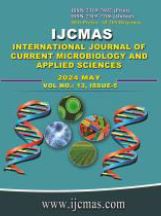


 National Academy of Agricultural Sciences (NAAS)
National Academy of Agricultural Sciences (NAAS)

|
PRINT ISSN : 2319-7692
Online ISSN : 2319-7706 Issues : 12 per year Publisher : Excellent Publishers Email : editorijcmas@gmail.com / submit@ijcmas.com Editor-in-chief: Dr.M.Prakash Index Copernicus ICV 2018: 95.39 NAAS RATING 2020: 5.38 |
Agro-textile is important segment of technical Textile. Agricultural textiles can improve quantity, quality and safety of agricultural products. Agricultural textiles should have excellent environmental resistance, mechanical properties, easy processability and durability characteristics. Today, in the field of agriculture and horticulture need has been realized for tomorrow. Various technologies are adopted to get higher overall yield, quality and tasty agro?products. In current scenario the consumer demands increasing for products which are free from harmful effect of chemicals, eco-friendly and suitable for hygienic life style. Demand is growing for textile products finished with natural antimicrobial finish. Therefore to achieve this goal Agrotech products are designed that have no harmful side effects. It will make extremely large impact on the financial state of farmers and well being of general public. Microencapsulation has proven as one of the most effective ways of incorporating desirable qualities to textile materials. There is a need to optimize the methods of producing microcapsules and extend the shelf life of treated materials. Pesticides are microencapsulated to be released over time, allowing farmers to apply the pesticides less often rather than requiring very highly concentrated and toxic initial applications. Similarly, in pharmaceutical industry microencapsulated products are designed for sustained/controlled release by either biodegradation of the shell, or by diffusion through the shell. The present research paper focuses on the work done in the field of application of essential oils as biopesticides in Agrotech. To check the efficacy of treated bag storage test was done. Significant difference was found between dead pests present outside and inside the treated bag. It was found that jute bag treated with Neem oil was found effective against pest. Germination test was done to find out the treatment which proved to be most effective in protecting damage of seed due to poor storage condition. Pigeon pea seeds stored for three months in control bag and treated bag under standard condition and conventional cloth bag under normal condition and after three months germination percentage calculated. It was found that germination percentage of seeds stored in treated bag was highest. Significant difference was found among germination percentage of seeds stored in convetional cloth bag, control bag and treated bag. It was found that germination percentage of seeds stored in microencapsulated bags varied with control bags.
Agarwal, S. K. 2013. Application of textile in Agriculture. International Journal of Advance Research in Science and Engineering. 2(7):9-18.
Alice Sujeetha R. P, C. V. Kavitha Abirami and K. Alagusundaram. 2014. Journal of Biopesticides. Biointensive safe storage methods for pulses: Review. 7(1):98-103. https://doi.org/10.57182/jbiopestic.7.1.98-103
Annual book of ASTM Standards. 2006.7.02. ASTM Internationals publications. West Con scohocken
Aswathaiah, B. et al., 1993. Handbook of Seed testing. National Seed Corporation Limited. Goverment of India undertaking: 45-92.
Chattopadhyay, S. N., Pan, N. C., Roy, A. N. and Samanta, K. K. 2021. Pretreatment of jute and banana fibre-its effect on blended yarn and fabric. J. of Natu. Fib. Retrieved from https://www.tandfonline.com/ https://doi.org/10.1080/15440478.2018.1469450
Ehsan, M. N., Ali, K., Tousif, M. H. and Zakaria, S. M. 2017. The Effect of Pretreatment on the Properties of Jute Yarn and Dyed Yarn Performance Analysis. Int. J of Scie. and Engg. Res., 8(12): 689-691.
ISI Handbook of Textile Testing. 1982. Indian Standards Institutions. New Delhi.
Miro Specos M M, García J J, Tornesello J, Marino P, Della Vecchia M, Defain Tesoriero M V, Hermid L G. 2010. Microencapsulated Citronella oil for Mosquito Repellent finishing of Cotton textiles. Transactions of the Royal Society of Tropical Medicine and Hygiene. 104: 653–658. https://doi.org/10.1016/j.trstmh.2010.06.004
Sinzogan, A. A. C., Kossou, D. K., Atachi, P., Van, H. A. 2006. Participatory evaluation of synthetic and botanical pesticide mixtures for cotton bollworm control. International journal Tropical Intitutes Science.26: 246-255. https://doi.org/10.1017/S1742758406415691
Wikipedia.2017. Retrieved from https://enwikipedia.org/wiki/Azadirachta indica on 4 April 2017.
 |
 |
 |
 |
 |